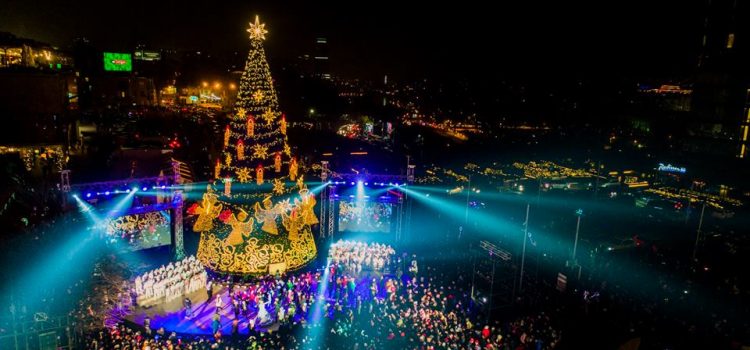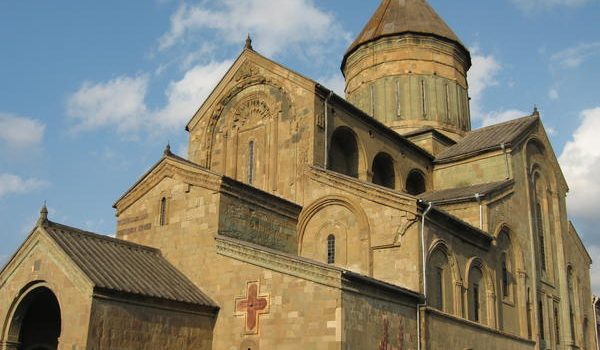Georgia marks national flag day
The current national flag was officially introduced on 14 January 2004.
The flag was used by the Georgian patriotic movement following the country’s independence from the Soviet Union in 1991.
By the late 1990s, the design had become widely known as ‘the Georgian historical national flag’ as vexillologists had pointed out the red-on-white Jerusalem cross shown as the flag of Tbilisi in a 14th-century map by Domenico and Francesco Pizzigano, the 14th century Venetian cartographers.
A majority of Georgians, including the Georgian church, supported the restoration of the flag that took place in 2004.
The winning entry replaced an earlier, three-colour flag first adopted for the 1918-1921 First Democratic Republic of Georgia before it was restored in 1990, ahead of Georgia’s proclamation of independence from the Soviet Union.
Drawn by painter Iakob Nikoladze, the design was selected for the original Republic that became independent from Imperial Russia following the 1917 Russian Revolution.
The State Council of Heraldry called upon Georgian citizens today to set and raise the national flag on their home windows, balconies, fences, roofs and cars to honour Georgian statehood and independence, national and individual freedoms.
Georgian President Salome Zurabishvili hosted a special event at her residency today and stated that the Georgian flag “symbolises the independence of the country, its freedom and everything which is valuable for us”.
The day of the national flag was first marked in 2012.
Source: Agenda.ge
Tbilisi gets ready to celebrate Christmas and New Year
Winter illuminations for Christmas and New Year are finally installed in Tbilisi, the capital of Georgia. Tbilisi’s main Christmas Tree was officially lit up on the First Republic Square on the 22nd of December. The event was accompanied by Christmas songs and performances. The prime Minister Mamuka Bakhtadze and the Tbilisi Mayor Kakha Kaladze participated in the event and wished the gathered people Happy Christmas and New Year.
Festive decorations were put on Rustaveli, Tamarashvili and Cholokashvili Avenues as well as Kostava,Baratashvili and Melikishvili Streets, which has made night strolls in Tbilisi even more enjoyable.
New Year’s traditions in Georgia
In Georgia, Europe and Asia have merged into a culture that is strangely not European nor Asian, but distinctly its own: Georgian. The mix of influences from the two continents has resulted in unique local traditions, cuisine, customs, and more that are unlike what you’ll find anywhere else — including how the locals ring in the new year.
If you want to have an authentic local experience in Tbilisi in December, touristy Rustaveli Avenue and Liberty Square are not the right places for that. Instead, visit Aghmashenebeli Avenue and the bazaar. Georgian bazaars are joyful and full of colours, and in the days leading up to December 31st, the bazaars are the most-visited places in the city as locals stock up on the goods they’ll need for New Year’s celebrations. While there are plenty of dishes, the highlight for locals is gozinaki, a sweet, homemade candy made from honey and walnuts — a New Year’s without this treat is simply unimaginable in Georgia. (Plus, it’ll keep the dentists in business for the new year!)
Another tradition is the tree: in Georgia, it isn’t just a Christmas tree that gets put up at the holiday, but a New Year tree, called a chichilaki. Traditional New Year trees are made from
shaved walnut or hazelnut tree branches, and then decorated with chocolates and fruit. These fluffy, lovely, handmade trees are believed to bring happiness and peace to your home. The sizes vary from several centimetres to a few metres, but don’t worry, the size of your tree doesn’t affect the amount of happiness or peace you’ll experience.
Generally, a chichilaki will stand in the living room, right next to the dinner table, so it can join you for a glass of heavenly Georgian wine at dinner. Kidding, trees don’t drink — but you do, right? If so, Tbilisi is the right place for you. Here, good wine is always a good idea, and we like to think that maybe wine is the answer to why Georgians are so artistic; the streets of Tbilisi are filed with local artists selling crafts. Head to Agmashenebeli Avenue, where you’re likely to find some amazing handcrafted wooden souvenirs. (You might also find farmers selling huge pumpkins from their fields, right there in the city centre.)
Between your New Year’s Eve supply shopping at the bazaar and your souvenir shopping on the streets, be sure to grab a local lunch to fuel you up. The streets of Tbilisi are full of nice cafés that offer khachapuri (cheese-filled bread), spinach pie, and other pastries, as well as plenty of street food.
Late in the day on December 31, when you’ve had enough good wine, nice art, and delicious food for the daylight hours, head back to your hotel to change and rush out to a New Year’s Eve party — where I’m sure you’ll find all those things (wine, art, and food!) in abundance!
Here is incredible tour in Georgia on New Year time:
ON OCTOBER 14 GEORGIA CELEBRATES THE GREAT FEAST OF SVETITSKHOVLOBA
This feast is celebrated in Georgia as a state holiday and declared a day-off.
Georgia celebrates a great Church feast on October 14—Svetitskhovloba. This day is dedicated to the Tunic of the Lord and the Life-giving Pillar, exuding wonder-working Myrrh, reports Novosti-Gruzia (“News-Georgia”).
His Holiness Catholicos-Patriarch of Georgia Ilia II on that day headed the solemn service in Svetitskhoveli—the most ancient Cathedral in the country.
The feast of Svetitskhovloba in Georgia is celebrated twice a year: on October 14, when it falls on the feast of the Protecting Veil of the Mother of God, and on July 13, when the Christian world celebrates the Synaxis of the Glorious and All-laudable twelve Apostles, to whom the church in the city of Mtskheta is dedicated.
According to the tradition, in the first century AD, Rabbi Helios bought the Tunic of the Lord from Roman soldiers in the Holy Land, and when he arrived in Mtskheta, he gave it to his sister Sidonia. The latter, having taken this relic into her hands, died at once. The Tunic could not be freed from her arms and Sidonia was buried together with it. A large tree grew on her grave, which became a sacred place for the residents of Mtskheta; miracles of healing occurred near it and even those people who did not confess Christianity venerated it all the same as they felt its particular power.
St. Nino, Equal-to-the-Apostles, having brought the Gospel to Mtskheta, asked tsar Mirian to cut down this tree, to make four Crosses from it and to set them on tops of the mountains on four sides of the state of Georgia of that time.
When the tree was miraculously sawn down and laid on the ground, then healing, wonder-working Myrrh began exuding from the remaining pillar. This continued till the 17th century and untill the invasion by shah Abbas I of Persia. The pillar became known as Life-giving—in Georgian “Svetitskhoveli”. The first Church in Georgia, dedicated to twelve Apostles of Christ, was built above it. In 1010-29, the architect Arsukidze built a magnificent Cathedral on this site. Svetitskhoveli was repeatedly subjected to destruction and was substantially reconstructed in the 15th-17th centuries.




